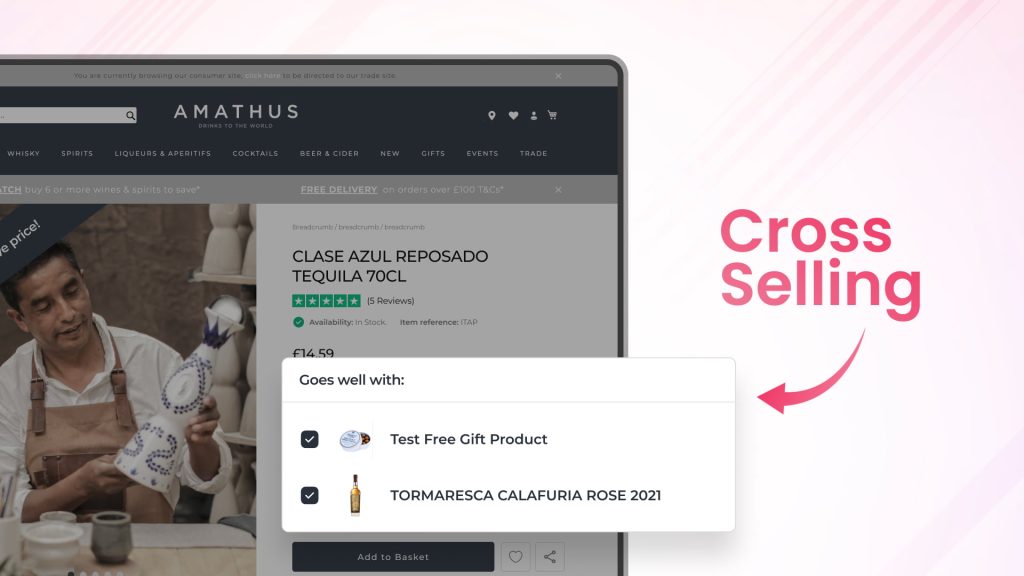How Upselling and Cross selling improved Online sales for our B2B Client?
- Jul 5, 2024
- By Tarun

Why settle for a single sale when, with the right upselling tactics and strategies, you can double or even triple your revenue? In the competitive B2B market, mastering cross-selling and upselling isn’t just a nice-to-have—it’s essential.
These strategies can transform one-time buyers into loyal customers while giving your bottom line a significant boost. We have successfully implemented these techniques for one of our clients who operates a B2B Ecommerce store built on Adobe Commerce. Stay with us to learn more about how we helped them grow their sales and revenue amidst the 8 B2B Commerce Trends in 2024 And Beyond.
Imagine every client interaction as an opportunity to offer more value, improve customer satisfaction, and drive higher profits. With the right approach, you can unlock new growth potential from your existing relationships.
Join us as we explore the art of upselling and cross-selling and discover how these powerful techniques can revolutionize your sales strategy and open doors to new opportunities for your B2B or B2C Business.
What is Cross-Selling?
Cross-selling is all about offering customers additional products or services that go well with their initial purchase. Think of it like suggesting the perfect side dish to go with the main course. By understanding what your client needs, you can recommend products that add more value to their original purchase.
This not only enhances their overall experience but also builds on the trust you’ve already established, making it easier to introduce new products down the line.
Examples of Cross-Selling
Offering add-on modules or complementary software that integrates with the main solution or suggesting related items like printers and toner when a company buys office computers.

What is Upselling?
Upselling is about encouraging customers to choose a higher-end version of the product or service they’re considering. It’s like suggesting the deluxe model of a car instead of the standard one. The goal of upselling is to provide more value to the customer by offering something better, which also helps increase the revenue per sale.
Examples of Upselling
Encouraging clients to buy a higher-end model with advanced features or proposing a more comprehensive service package that includes strategic planning and implementation support.

How Upselling and Cross-Selling Improve B2B Sales for Our Clients
One of our clients, Amathus, implemented upselling and cross-selling features in their store along with a bulk order option. This strategic enhancement not only revamped their website’s functionality but also drove significant sales growth.
Implementing upselling and cross-selling strategies significantly boost B2B sales for our client in several ways:
- Revenue Growth: By maximizing the value of each transaction, clients can see a substantial increase in their revenue. A study by Bain & Company found that increasing customer retention rates by 5% can increase profits by 25% to 95%. When businesses strategically upsell and cross-sell, they effectively drive higher sales volumes without the need to acquire new customers.
- Customer Retention: Offering a comprehensive range of products and services tailored to client needs fosters long-term relationships and loyalty. Research by the Harvard Business Review indicates that acquiring a new customer is five to 25 times more expensive than retaining an existing one. By consistently meeting client needs through upselling and cross-selling, businesses can enhance customer loyalty and reduce churn.
- Competitive Advantage: Clients who effectively use these strategies can differentiate themselves by providing superior value and solutions. According to a report by PwC, 86% of buyers are willing to pay more for a better customer experience. By offering tailored upsell and cross-sell options, businesses can stand out in the marketplace, attracting and retaining clients through exceptional service and comprehensive solutions.
- Enhanced Client Insights: Understanding client needs and preferences through these strategies can lead to more personalized and effective sales approaches. A study by Salesforce found that 57% of consumers are willing to share personal data in exchange for personalized offers or discounts. Upselling and cross-selling provide valuable insights into client behavior, enabling businesses to tailor their offerings more precisely and effectively.
Additional Features that Boosted B2B Sales for Amathus
Bulk Order Option
One of the standouts features we implemented for Amathus was the bulk order option. This feature was particularly beneficial for their B2B clients who often need to purchase large quantities of products at once. Here’s how the bulk order option contributed to their sales growth:
Streamlined Purchasing Process: The bulk order option simplified the purchasing process for B2B clients, allowing them to quickly add large quantities of items to their cart without having to go through the tedious process of adding each item individually. This efficiency not only saved time but also enhanced the overall shopping experience.
Volume Discounts: By integrating volume discounts with the bulk order option, Amathus was able to incentivize larger purchases. Clients were encouraged to buy more to take advantage of the cost savings, thereby increasing the average order value and overall sales.
Inventory Management: The bulk order feature was seamlessly integrated with Amathus’s inventory management system. This ensured that stock levels were accurately tracked, preventing overselling and stockouts, which could negatively impact customer satisfaction and retention.
Customized Order Handling: For their B2B clients, Amathus offered customized order handling, such as personalized invoicing and flexible shipping options. These tailored services further enhanced the appeal of the bulk order option, making it easier for clients to manage their purchases and logistics.
Enhanced Customer Support: To support the bulk order option, Amathus also enhanced their customer support services. Dedicated account managers and a responsive support team were available to assist B2B clients with any issues or special requests, ensuring a smooth and satisfying purchasing experience.
Before and After Results
Before our intervention, Amathus had a straightforward but limited ecommerce platform. By integrating upselling and cross-selling features, we transformed their website into a dynamic sales engine. Below are the before and after images showcasing the website’s transformation and the impressive impact on sales.
Before Implementation: Website Look: Simple, with limited product recommendations. Sales (%): Moderate, with minimal upselling and cross-selling opportunities.
After Implementation: Website Look: Enhanced with personalized product suggestions and bulk order options. Sales Increase (%): A remarkable 40% increase in overall sales.”

Client Feedback Says It all
Amathus left us a glowing Google review, praising the effectiveness of the new features and the substantial improvement in their sales performance.

Conclusion
Upselling and cross-selling are powerful tools in the B2B and B2C business sales toolkit. When used strategically, they can lead to increased revenue, enhanced customer satisfaction, and stronger client relationships. At RVS Media, it’s crucial to approach these strategies with a focus on delivering genuine value to clients to avoid potential drawbacks. Mastering the art of upselling and cross-selling can help businesses achieve sustainable growth and long-term success.
Cross-Selling and Upselling: FAQs
Q1: How can we ensure our cross-selling and upselling efforts are well-received by clients?
Focus on understanding the client’s needs and tailor your recommendations to provide genuine value. Avoid overwhelming clients with too many options and ensure that any upsell, or cross-sell aligns with their goals.
Q2: What are some best practices for implementing these strategies in a B2B context?
Train your sales team to identify opportunities, build strong client relationships, and use data-driven insights to make personalized recommendations. Regularly review and refine your strategies based on client feedback and sales performance.
Q3: Can these strategies be automated?
Yes, many CRM and sales automation tools offer features to suggest cross-sell and upsell opportunities based on client data and purchase history. Automation can enhance efficiency and consistency in applying these strategies.
 Shopify
Shopify

















